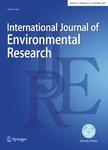版权所有:内蒙古大学图书馆 技术提供:维普资讯• 智图
内蒙古自治区呼和浩特市赛罕区大学西街235号 邮编: 010021

作者机构:Pandit Deendayal Energy Univ Sch Energy Technol Dept Chem Gandhinagar 382426 Gujarat India Pandit Deendayal Energy Univ Sch Technol Dept Comp Sci & Engn Gandhinagar 382007 Gujarat India Pandit Deendayal Energy Univ Sch Technol Dept Mech Engn Gandhinagar 382007 Gujarat India Gurukul Kangri Dept Chem Hardwar 249404 Uttrakhand India Minist Environm Forests & Climate Change Ctr DNA Taxon Mol Systemat Div Zool Survey India Kolkata 700053 West Bengal India
出 版 物:《INTERNATIONAL JOURNAL OF ENVIRONMENTAL RESEARCH》 (Int. J. Environ. Res.)
年 卷 期:2025年第19卷第3期
页 面:1-27页
核心收录:
基 金:Government of Gujarat as a Junior Research Fellow (JRF) under the ScHeme Of Developing High-Quality Research (SHODH). [KCG/SHODH/2022-23/202101585] Government of Gujarat Department of Chemistry, SRDC (Solar Research and Development Centre)
主 题:Biochar-ZnO Photocatalytic degradation Agrochemical Wastewater treatment Predictive modeling
摘 要:To accommodate rising food demand, the agricultural industry has expanded significantly. The widespread use of agrochemicals has generated concerns about their environmental effect, notably on water quality and aquatic biodiversity. The buildup of pesticide residues in water bodies has long-term consequences for marine life and general ecosystem health. The present work describes the synthesis of biochar-ZnO nanocomposites with varying ZnO concentrations using a solid thermal decomposition technique. The produced biochar-ZnO nanocomposites were thoroughly characterized to validate their composition, structure, and characteristics. Diffraction techniques were used to establish crystal structure, spectroscopy for molecular and electronic analysis, electron microscopy for detailed imaging of particle dispersion, and thermal analysis to check stability and composition. These nanocomposites potential as photocatalysts for degrading atrazine (ATZ) and 2,4-dichlorophenoxyacetic acid (2,4-D) in aqueous solutions was studied, with 93% and 90% degradation efficiency at 1 mg/mL dosage in 90 min. pH, loading experiments, catalyst dosage, and recycling studies were investigated. In addition, mineralization tests, scavenger investigations, and a comprehensive degradation process have been investigated. Furthermore, the prediction ability of machine learning (ML) models such as Support Vector Machine (SVM), Random Forest (RF), and Artificial Neural Network (ANN) was assessed to predict the percentage removal of contaminants. The SVM model outperformed the RF and ANN models, with RMSE of 4.93, MAE of 4.38, and R2 of 0.95, respectively. This work emphasizes the potential of biochar-ZnO nanocomposites as efficient photocatalysts and the efficacy of machine learning algorithms in improving photocatalytic treatment techniques for agrochemical degradation.